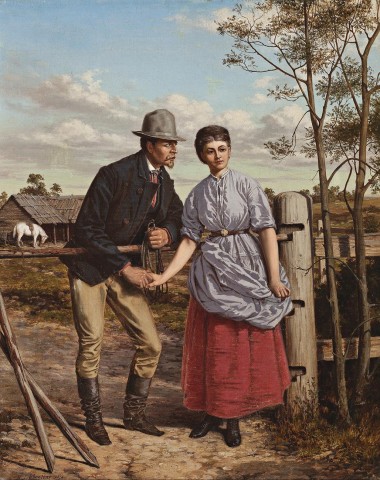WOOED AND WON, 1874 (ALSO KNOWN AS 'A BUSH ROMANCE’)
HENRY JAMES JOHNSTONE
oil on canvas
54.0 x 42.0 cm
signed and dated lower left: H. J. Johnstone 1874
signed and inscribed verso: H. J. Johnstone / No. 2
Private collection
Leonard Joel, Melbourne, 23 July 1986, lot 96 (as ‘A Bush Romance’)
Christopher Day Gallery, Sydney
Private collection, Sydney
Fourth Exhibition, Victorian Academy of Arts, Melbourne, 1874, cat. 38
An Australian Perspective: An Important Collection of Fine Colonial Works and Early 20th Century Paintings 1820 – 1952, Christopher Day Gallery, Sydney, September 1988, cat. 17 (illus. in exhibition catalogue, as ‘A Bush Romance’)
‘The Victorian Academy of Arts Third Notice’, The Argus, Melbourne, 15 August 1874, p. 5
‘Victorian Artists In London’, The Age, Melbourne, 7 November 1891, p. 14 (as ‘A Pressing Question’)
A Pressing Question, 1874, colour wood engraving, 42.2 × 32.2 cm, in the collection of the National Gallery of Victoria, Melbourne
The depiction of love in the nineteenth-century took a variety of forms, the eager, sentimental and moralistic included. In Wooed and Won, 1874, Henry James Johnstone chose the genre of the bush romance, a slice of contemporary life engaging the anecdotal to the naturalism of figures and landscape. Bathed in the sunny light of Australian optimism, the country gallant woos his maiden fair. Bending ever so slightly, his earnest endeavour is profiled with intent. Right hands link in hope. His left grips a whip, with his still saddled, earlier love, relegated to the background. Rich in metaphors, only one slip rail remains to separate the couple. To the right, branches of two young trees entwine. When shown in the annual exhibition of Victorian Academy of Arts, Melbourne, in October 1874, the reviewer for The Argus declared it: ‘noteworthy on account of the Flemish finish of the drapery, and the ability with which the artist has contrived to make both the persons who figure in this rustic idyll tell the story’.1
Most of the exhibited works were of the Australian landscape. The very occasional subject picture included Impudence by Henry Rielly and His First Model by George Sutherland, an amusing domestic scene of a young boy busily drawing the doll proudly held by his sister. Significantly, it was one of only three works selected by The Illustrated Australian News to illustrate the accompanying review, which observed: ‘it would give greater interest to the exhibition if a few more of our artists would devote themselves to figure subjects’.2 Johnstone continued his theme of love in the landscape the following year in The Dipping Place, Dandenong Creek.3
Enticed by gold to Australia in 1853, the flamboyant Johnstone returned to Melbourne, soon rising in prominence as both a photographer and painter. Exhibiting with the Victorian Academy of Arts from 1872, by 1875 he was singled out as ‘decidedly a rising artist, and if it be considered how comparatively short is the time since he first began to exhibit, it must be conceded that he made great progress. Mr. Johnstone combines delicacy of touch with a true eye for colour, and it is very felicitous in reproducing the characteristics of the Australian scenery’.4 Johnstone, together with Eugène von Guérard, Louis Buvelot, S. T. Gill and others was represented in the collection of the great benefactor of the National Gallery of Victoria, Alfred Felton. Johnstone’s extraordinarily popular oil painting, Evening Shadows, Backwater of the Murray, South Australia, 1880, was the first work acquired by the Art Gallery of South Australia.
1. ‘The Victorian Academy of Arts. Third Notice’, The Argus, Melbourne, 15 August 1874, p. 5
2. ‘Victorian Academy of Arts Exhibition’, The Illustrated News for Home Readers, Melbourne, 7 September 1874, pp. 152 (illus.), 154
3. The Fifth Exhibition of the Victorian Academy of Arts, Melbourne, 1875, cat. 29
4. Victorian Intercolonial Exhibition 1875, Preparatory to the Philadelphia Exhibition 1876, Official Catalogue of Exhibits, Melbourne, September 1875, ‘Fine Arts’, pp. 208 – 9
DAVID THOMAS
